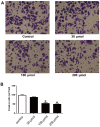Identification of candidate drugs for the treatment of metastatic osteosarcoma through a subpathway analysis method
- PMID: 28599440
- PMCID: PMC5453166
- DOI: 10.3892/ol.2017.5953
Identification of candidate drugs for the treatment of metastatic osteosarcoma through a subpathway analysis method
Abstract
Osteosarcoma (OS) is the third most frequent type of cancer in adolescents and represents >56% of all bone tumors. In addition, metastatic OS frequently demonstrates resistance to conventional chemotherapy; thus, the development of novel therapeutic agents for the treatment of patients with metastatic OS is warranted. In the present study, the metabolic mechanisms underlying OS metastasis were investigated using a subpathway analysis method and lead to the identification of candidate drugs for the treatment of metastatic OS. Using the GSE14827 microarray dataset from the Gene Expression Omnibus database, 546 differentially expressed genes were identified between samples from patients with OS who did or did not develop metastatic OS. Furthermore, nine significantly enriched metabolic subpathways were identified, which may be involved in OS metastasis. Finally, using an integrated analysis of metastatic OS-associated subpathways and drug-affected subpathways, 98 small molecule drug candidates capable of targeting the metastatic OS-associated subpathways were identified. This method identified existing anti-cancer drugs, including semustine, in addition to predicting potential drugs, such as lansoprazole, for the treatment of metastatic OS. Transwell and wound healing assays demonstrated that lansoprazole reduced the invasiveness and migration of U2OS cells. These small molecule drug candidates identified through a bioinformatics approach may provide insights into novel therapy options for the treatment of patients with metastatic OS.
Keywords: drugs; metabolic subpathways; metastatic osteosarcoma; network.
Figures



Similar articles
-
Integrating subpathway analysis to identify candidate agents for hepatocellular carcinoma.Onco Targets Ther. 2016 Mar 7;9:1221-30. doi: 10.2147/OTT.S97211. eCollection 2016. Onco Targets Ther. 2016. PMID: 27022281 Free PMC article.
-
Identification of differentially expressed genes in the development of osteosarcoma using RNA-seq.Oncotarget. 2016 Dec 27;7(52):87194-87205. doi: 10.18632/oncotarget.13554. Oncotarget. 2016. PMID: 27888627 Free PMC article.
-
Identification of biomarkers for metastatic osteosarcoma based on DNA microarray data.Neoplasma. 2015;62(3):365-71. doi: 10.4149/neo_2015_044. Neoplasma. 2015. PMID: 25866217
-
Chalcone Derivatives 4'-Amino-1-Naphthyl-Chalcone (D14) and 4'-Amino-4-Methyl-1-Naphthyl-Chalcone (D15) Suppress Migration and Invasion of Osteosarcoma Cells Mediated by p53 Regulating EMT-Related Genes.Int J Mol Sci. 2018 Sep 19;19(9):2838. doi: 10.3390/ijms19092838. Int J Mol Sci. 2018. PMID: 30235848 Free PMC article.
-
Identification of key genes in osteosarcoma by meta‑analysis of gene expression microarray.Mol Med Rep. 2019 Oct;20(4):3075-3084. doi: 10.3892/mmr.2019.10543. Epub 2019 Jul 31. Mol Med Rep. 2019. PMID: 31432118 Free PMC article.
Cited by
-
A Multi-Objective Approach for Anti-Osteosarcoma Cancer Agents Discovery through Drug Repurposing.Pharmaceuticals (Basel). 2020 Nov 22;13(11):409. doi: 10.3390/ph13110409. Pharmaceuticals (Basel). 2020. PMID: 33266378 Free PMC article.
-
A Subpathway and Target Gene Cluster-Based Approach Uncovers lncRNAs Associated with Human Primordial Follicle Activation.Int J Mol Sci. 2023 Jun 23;24(13):10525. doi: 10.3390/ijms241310525. Int J Mol Sci. 2023. PMID: 37445702 Free PMC article.
-
Citrus aurantium Naringenin Prevents Osteosarcoma Progression and Recurrence in the Patients Who Underwent Osteosarcoma Surgery by Improving Antioxidant Capability.Oxid Med Cell Longev. 2018 Feb 7;2018:8713263. doi: 10.1155/2018/8713263. eCollection 2018. Oxid Med Cell Longev. 2018. PMID: 29576857 Free PMC article.
References
LinkOut - more resources
Full Text Sources
Other Literature Sources
